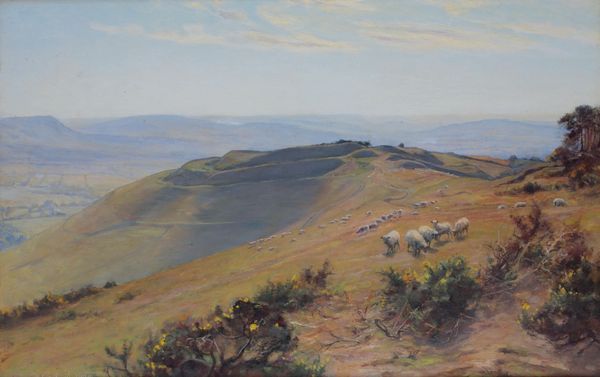Bidding ended. Lot has been sold.
FREDERICK WHITEHEAD (1853-1938) 'Bulbarrow' an extensive landscape depicting sheep atop Bulbarrow Hill, Dorset, overlooking the Blackmore Vale, signed and dated 1894 lower left, oil on canvas, 35cm x 55cm Provenance: Commissioned by Thomas Hardy (1840-1928) as a reduced version of Whitehead's 'Blackmore Vale (from Bulbarrow)' (exhibited Bond Street, London). The Estate of Dr. E. W. Mann, Thomas Hardy's physician, and thence by descent "Among the first British impressionists exhibiting art specifically relating to Hardy's Wessex - with landscapes viewed through a Hardyean lens - were Arthur Meade and Frederick Whitehead. Working en plein air - directly from nature - together they embraced the Hardy brand - which was advantageous for them when exhibiting and selling work in London's Royal Academy and other galleries. Both new Hardy and were aware of his writings of the Wessex countryside, they wrote of reading his novels in the evening, relishing the descriptive passages of every hamlet of cob and thatch, and then painting his landscape settings by day. They often adopted overt Hardy references in their titles and accompanying text to make their work more commercial. Artists exhibiting in London's competitive art market exploited the commercial benefits of this Hardy/Wessex connection in trying to sell their paintings. They held exhibitions in Bond Street, one was described in The Times as a series of pictures of Thos Hardy's Country by various artists comprising 70 original works painted expressly for the exhibition. And another show that summer simply bore the title Wessex. Critics noted that Whitehead's work attracted considerable attention outside art circles because of Mr. Hardy's connection with the county.To further emphasise the point, Whitehead accompanied his work with relevant Hardy quotations, often from Tess or the Return of the Native. This nexus between pictures, place and words was sanctioned by Hardy who so admired Whitehead's large painting of Blackmore Vale [from Bulbarrow] - that he commissioned a smaller version. Hardy's wife Emma painted landscapes explicitly acknowledging Whitehead's influence, closely copying his work, as in her painting of Bulbarrow, which she inscribed as 'after Whitehead'. Emma sometimes wrote poems to accompany Whitehead's Dorset paintings. Various professional artists held one-man shows in Dorchester in which Hardy took an active interest, encouraging and promoting their capture of the countryside and its responses invoked in his writing. Hardy's correspondence reveals long-standing friendships with artists and he maintained a close personal association with those with local connections often influencing their choice and interpretation of landscapes captured on the spot. Whitehead and Meade both married local girls. Beatrice Case who married Whitehead introduced him both to Dorchester and Hardy, the year he exhibited his first unambiguously Hardy subject at the RA Tess of the D'Urbervilles ancestral home in 1893. His close intimacy with the heathlands, hillsides and river-banks described by Hardy in his novels, resulted in broad impressionistic topographical views, using a muted palette under varying atmospheric conditions." Gwen Yarker
Read more

